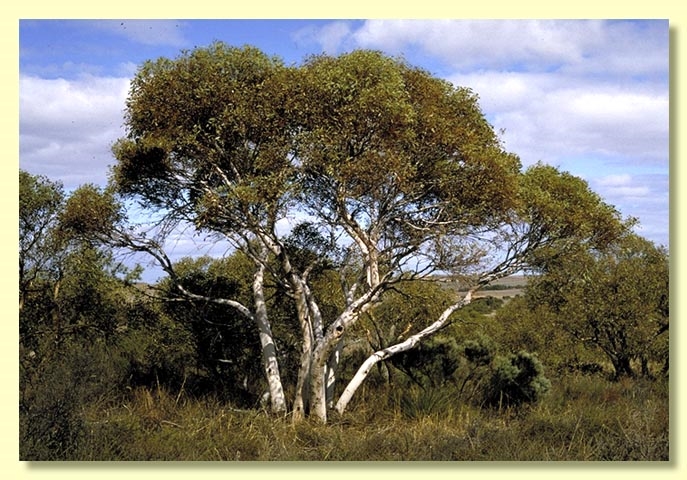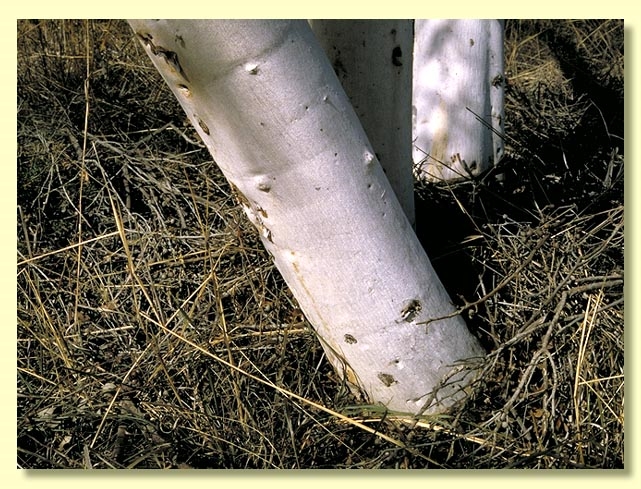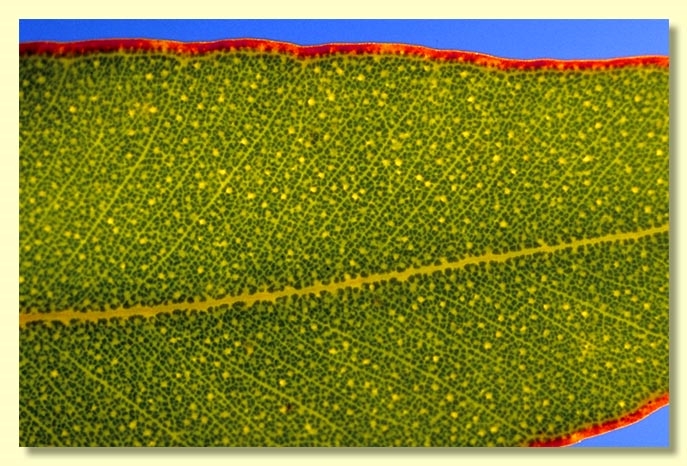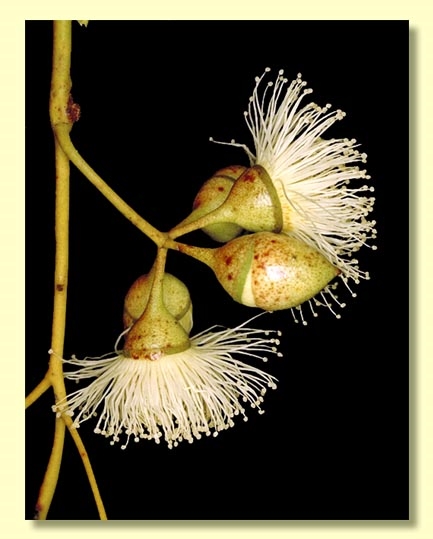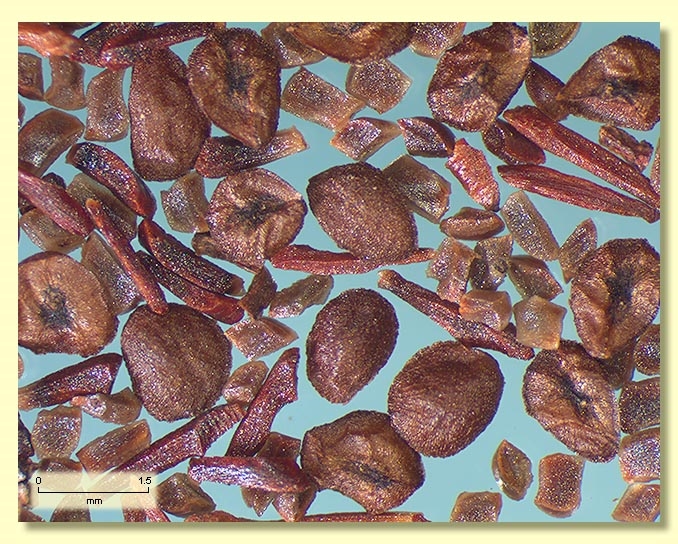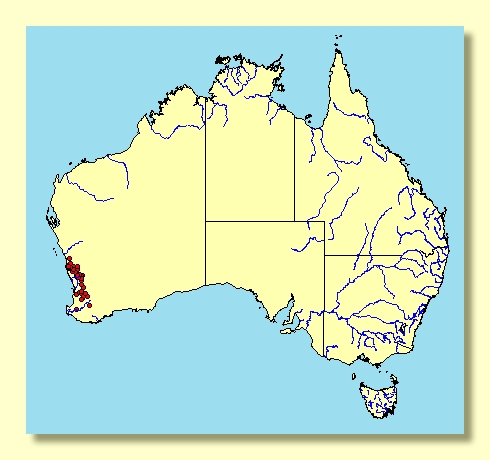Euclid - Online edition
Eucalyptus drummondii
Eucalyptus | Symphyomyrtus | Bisectae | Destitutae | Curviptera | Xylocarpae
E. oldfieldii var. drummondii (Benth.) Maiden, Crit. Revis. Eucalyptus 2: 223 (1912).
T: between Swan River and King George Sound, W.A., J.Drummond 2nd Coll. no. 86. ; lecto: K; isolecto: BM, CGE, E, NSW, W, fide J.H.Maiden, Crit. Revis. Eucalyptus 2: 223 (1912).
Bark smooth throughout, often powdery, whitish to grey and red-brown mottled.
Branchlets lacking oil glands in the pith.
Juvenile growth (coppice or field seedlings to 50 cm): stems rounded in cross-section; juvenile leaves always petiolate, alternate, ovate or orbicular becoming elliptical, 5.5–8 cm long, 1.8–5.5 cm wide, dull, green to slightly glaucous.
Adult leaves alternate, petioles 0.7–2.2 cm long; blade narrowly elliptical to oblong to ovate or lanceolate, (3.2)4–7(8) cm long, (0.8)1–2(2.7) cm wide, base tapering to petiole, margin entire, apex acute to rounded, dull, green to bluish green, side-veins greater than 45° to midrib, reticulation very dense, intramarginal vein close to margin, oil glands intersectional.
Inflorescence axillary unbranched, peduncles sometimes pendulous, 0.7–3 cm long, buds 7 per umbel, pedicellate (pedicels 0.2–1.2 cm long). Mature buds ovoid (0.8–1.8 cm long, 0.4–1 cm wide), rarely globular, sometimes glaucous, scar present, operculum broadly conical to rounded and apiculate, stamens all obliquely erect or the inner stamens variably inflexed, anthers cuboid, versatile, sub-basifixed, dehiscing by longitudinal slits, style long and straight, stigma blunt, locules 3 or 4, the placentae each with 4 vertical rows of ovules. Flowers white.
Fruit pedicellate (pedicels 0.3–1(1.3) cm long), hemispherical, 0.5–0.9(1.2) cm long, (0.8)1–1.2(1.4) cm wide, rim moderately narrow, disc broad and ascending or level, valves 3 or 4, strongly exserted.
Seeds brown, 1–3 mm long, flattened-ovoid or slightly angular, dorsal surface shallowly reticulate, hilum ventral.
Cultivated seedlings (measured at node 10): cotyledons Y-shaped (bisected); stems rounded in cross-section, young stems glaucous but wax soon lost; leaves always petiolate, opposite for 5 to 7 nodes then alternate, broadly ovate-elliptical or orbicular, 5.5–7 cm long, 1.8–5.5 cm wide, base tapering to rounded or truncate, apex pointed or rounded, dull, green to grey-green or developing leaves slightly glaucous.
Flowering has been recorded in April, June, August, September, October, November and December.
A small mallee endemic to Western Australia, widespread north and south of Perth, from Eneabba and Wongan Hills south to Bridgetown and Woodanilling. The bark is smooth, usually white and powdery and the adult leaves are dull, light green to grey-green. It usually occurs on gravelly sites on granite or laterite.
Eucalyptus drummondii belongs in Eucalyptus subgenus Symphyomyrtus section Bisectae subsection Destitutae because buds have two opercula, cotyledons are Y-shaped and branchlets lack oil glands in the pith. Within this subsection E. drummondii is one of about 30 closely related species and subspecies that form series Curviptera, which is further characterised by having large buds in umbels of one, three or seven, staminal filaments erect or oblique (rarely inflexed) in bud, and large fruit with a usually ascending disc and exserted valves.
Eucalyptus drummondii is distinguished within series Curviptera by the combination of small elliptical leaves (less than 8 cm long), fruit less than 1.2 cm wide, ovoid buds in sevens and smooth powdery bark. Within its geographic range it is most likely to be confused with E. lane-poolei, which commonly has longer, more falcate leaves and globular buds with inflexed stamens, and E. annuliformis, which has similar leaves (to E. drummondii), larger buds and fruit with a flat disc. In the north-east of the geographic range of E. drummondii the related species E leptopoda subsp. arctata occurs. This differs in having narrower crown leaves that lack an intramarginal vein, slightly smaller fruit and has white bark in season but is not powdery.
Note about Eucalyptus graniticola (unpublished name attributed to S.D. Hopper & M.I.H. Brooker, of which specimen Brooker 9807 is an example). This name has received some publicity in Western Australia in recent years. The name has been applied to a single plant in the wild, a mallee from near Wagerup, south of Perth. It grows on a granite slope, and DNA studies (Rossetto et al. 1996) have shown it to be a hybrid between E. drummondii and E. rudis subsp. rudis. E. graniticola Brooker & Hopper ms is listed as "Endangered" under the Australian Government Environment Protection and Biodiversity Conservation Act 1999 (EPBC Act). Further information may be found at this web address:
http://www.environment.gov.au/cgi-bin/sprat/public/sprat.pl

